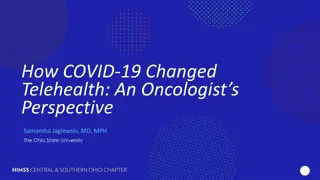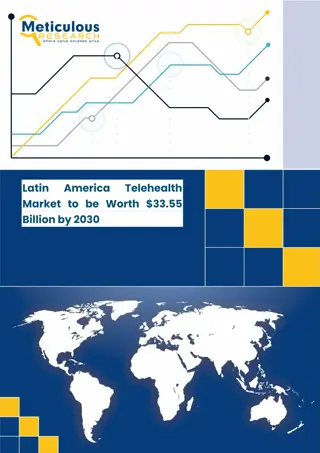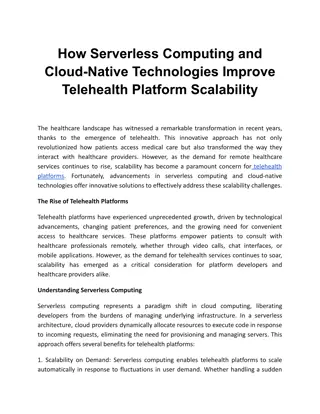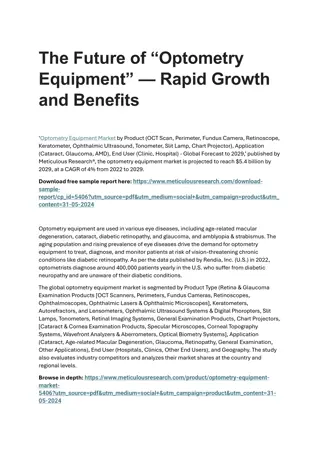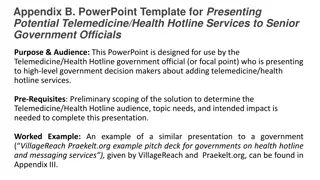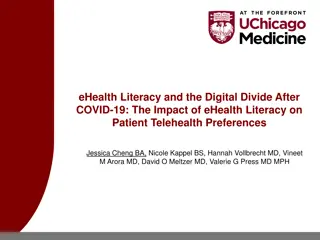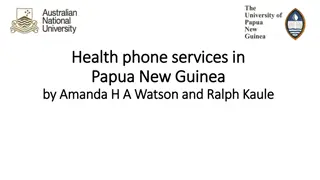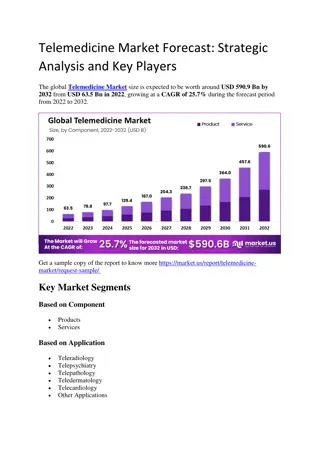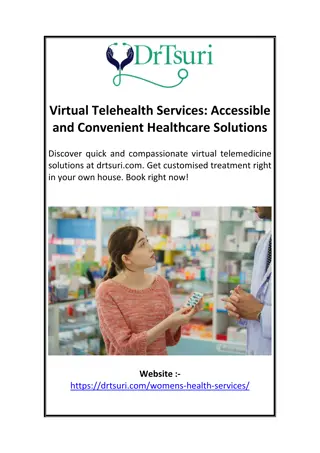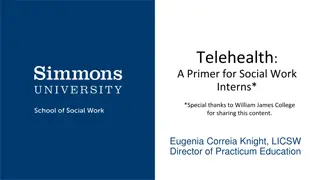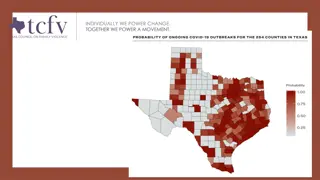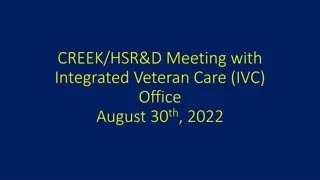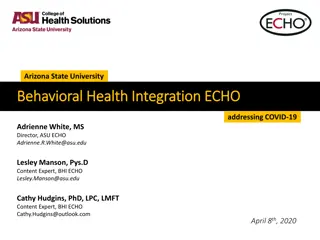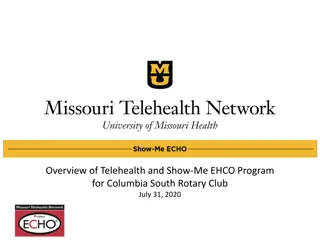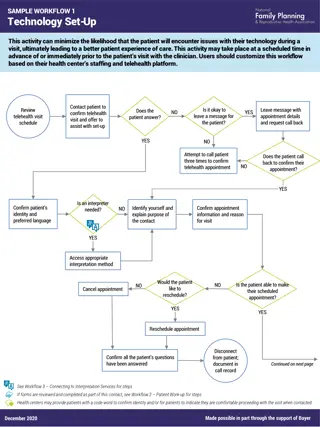Understanding Telehealth and Telemedicine: Advantages and Applications
Telehealth and telemedicine revolutionize healthcare delivery by leveraging telecommunications technologies to provide remote health-related services and information. This article delves into defining telehealth and telemedicine, exploring their history, identifying driving forces, listing advantages, discussing equipment and technology requirements, and highlighting various telehealth applications. The growth and potential of telehealth, along with its role in patient-provider communication and self-management, are also emphasized.
Download Presentation

Please find below an Image/Link to download the presentation.
The content on the website is provided AS IS for your information and personal use only. It may not be sold, licensed, or shared on other websites without obtaining consent from the author. Download presentation by click this link. If you encounter any issues during the download, it is possible that the publisher has removed the file from their server.
E N D
Presentation Transcript
Telehealth Offered by Suliman Alomran, RHIA
Objectives Define Telehealth and Telemedicine History of Telehealth Identify Driving Forces of Telehealth List the Advantages of Telehealth Identify equipment and technology to sustain telehealth Identify several telehealth applications
It is Already There! Telehealth is projected to reach 1.8 million patients worldwide by 2017 In 2012, 308,000 patients remotely monitored for Congestive heart failure (CHF), Chronic obstructive pulmonary disease (COPD), Diabetes hypertension and mental health conditions worldwide http://www.healthcareitnews.com/news/telehealth-growth-mode-worldwide
Define Telehealth and Telemedicine Telehealth defined: The delivery of health-related services and information via telecommunications technologies Could be: (nonclinical services) Two healthcare professionals discussing a case over the phone; Using videoconferencing between providers at facilities in two countries Telenuring Practice Guidelines https://www.crnns.ca/documents/Telenursing2014.pdf
Define Telehealth and Telemedicine Telehealth can promote: Patient-provider communication Patient self-management with provider feedback Health literacy Provider-provider consultants Telenuring Practice Guidelines https://www.crnns.ca/documents/Telenursing2014.pdf
Telehealth System Overview Transmits data (Vital Sign) from home to a healthcare professional by use of ICT. http://www.ecnmag.com/articles/2011/03/wireless-technologies-build-momentum-telehealth-systems
Top Telehealth Tools for Patients http://www.hin.com/chartoftheweek/patient_telehealth_tools_printable.html
Define Telehealth and Telemedicine Telemedicine defined: the use of electronic information and communication technologies to provide and support health care when distance separates the participants Combination of: Telecommunications Technology Medicine (clinical services) Telenuring Practice Guidelines https://www.crnns.ca/documents/Telenursing2014.pdf
Types of telemedicine interaction Real-time (for Emergency use) Parties communicate simultaneously via a telecommunication network, also called synchronous or interactive Store and forward (Non- Emergency use) Involves non-interactive transmission of information from on site to another. Sometimes referred to as asynchronous or pre-recorded and involves information being captured and then transmitted to the other party for advice, opinion or specialist consultation Hybrid Method
Categories of Telemedicine Patient Monitoring (Home care) Blood pressure monitors Interactive Applications Teleconsulting, Videoconferencing Store and forward applications Medical images, lab results
Hub Site Remote Site T-1
Telemedicine Telesurgery Telepsychiatry Telecare Tele-health Tele- E-Health/ Education healthcare (Winters, 2002)
Telehealth vs. Telemedicine (Winters, 2002)
History of Telehealth (Wittson, Affleck, and Johnson)
Period Telegraph Telephone application 1835 Telegraph Used in the American Civil War to deliver casualty lists and order supplies. Later used to transmit x-ray images. Initially used for voice communicaion. About 30 years later, used to transmit ECGs and EEGs. 1876 Telephone 1895 Radio Used to supply medical advice to seafarer. In 1920 the Seaman s Church Institute of New York provided medical care using radio. The CIRM in Rome has been using radio to provide A two-way closed circuit television link was set up between the Nebraska Psychiatric Institute in Omaha and the state mental hospital in Norfolk for educational purposes. Videoconferencing for health purposes became more common Late 1960s Video/ television 1990s Videoconfer encing Internet Mid- 1990s Use of the internet for health purpose
Participants in the telehealth interaction The nature of the communication in health can be Patient with practitioner Practitioner with Practitioner (Teleradiology) Patient with patient (that is, mutual support) Practitioner or patient accessing educational material (that is, source of health information)
Participants in the telehealth interaction The nature of the communication in health can be Patient with practitioner Telepsychiatry is a common telehealth application usually performed by videoconferencing An evaluation of Telepsychiatry services in Alberta, Canada, showed that it was acceptable to users and there were significant cost savings from avoided travel by psychiatrists and patients Chapter 19 Telehealth and Communication http://www.powershow.com/view/12d046NWMxM/Chapter_19_Telehealth_and_Communication_powerpoint_ppt_presentation
Participants in the telehealth interaction The nature of the communication in health can be Patient with patient (that is, mutual support) Support groups : communication between people who have similar conditions, A study of the use of audio conferencing by breast cancer patients in rural Newfoundland showed that it provided valuable mutual support, despite the distances. Chapter 19 Telehealth and Communication http://www.powershow.com/view/12d046NWMxM/Chapter_19_Telehealth_and_Communication_powerpoint_ppt_presentation
Driving Forces of Telehealth Quality Healthcare Access Cost
Is At the Point of Care Too Late? Health care spending Health Status Early Clinical Sympto ms Healthy / Low Risk High Risk At Risk 20% of people generate 80% of costs - Early detection of at-risk patients - Provide personalized evidence to enable pro-active decisions
Driving Forces of Telehealth Quality of Care Provide diagnostics New mode of treatment Improve patient satisfaction (early treatment, higher frequency of encounter
Driving Forces of Telehealth Access to Care Access for people with situational limitations (physical disabilities, elderly, etc) Minimize distance of travel for people in hard to reach/isolated locations Not limited by time/place
Driving Forces of Telehealth Cost of Care Prevent/early treatment of disease = lower cost of care (both to provider and society) Lower cost from travel
Why do Telemedicine/Telehealth? Access: Time, Travel, Expense, Information Health Provider Collaboration Enhanced Communications TV & Computer Applications common and non- threatening Minimize referrals
Why do Telemedicine/Telehealth? Communication/Collaboration with specialists ER front-line support Improved professional education Saves time, travel to outreach clinics
List the Challenges of Telehealth Infrastructure Liability Privacy End-user lack of knowledge about the benefits, services available in other settings Compromisedrelationship between health professional and patient Lack of time to adopt telemedicine
Identify equipment and technology to sustain telehealth Equipment to capture the information at each site Communication equipment to transmit this information between the sites Equipment to display the information at the relevant sites Four types of information transfer common in telehealth Audio, text, still images, video Chapter 19 Telehealth and Communication http://www.powershow.com/view/12d046NWMxM/Chapter_19_Telehealth_and_Communication_powerpoint_ppt_presentation
Telemedicine Settings Rural area Schools Clinics Hospitals Prisons Assisted living
Emerging Telemedicine applications Telestroke Teledermatology Teleconsults Telewound care TeleICU Teleophthalmology Telecardiology Pre and post-surgical care Telepsychiatry Telepathology Teleradiology TeleEndocrine TeleTrauma TelePediatrics eVisits
Emerging Telemedicine applications Telehealth Post-discharge Reduce hospital readmissions Improve clinical outcomes, compliance Improve patient quality of life Improve patient education and self-care
Emerging Telemedicine applications For Stroke Patients: To be effective, clot-dissolving therapies must be given within three to four and a half hours after you experience stroke symptoms. http://www.mayoclinic.org/tests-procedures/stroke-telemedicine/basics/definition/prc-20021080
Emerging Telemedicine applications Telestroke ER Consultant do a CT Scan; Trained neurologist performs a live, real- time audiovisual consultation make diagnosis and appropriate treatment recommendations; Send documentation electronically http://www.mayoclinic.org/tests-procedures/stroke-telemedicine/basics/definition/prc-20021080
Emerging Telemedicine applications Teledermatology Inpatient and emergency consults for hospitals without dermatology coverage. Timely transmission of images and clinical information. Educational opportunities for residents and fellows.
Emerging Telemedicine applications Emergency Care and Trauma Timely trauma evaluations for patients in remote or rural areas. Assistance with triage and transfer decisions. Learning opportunities for community providers.
Emerging Telemedicine applications Tele Wound Care Remote consults for patients with poorly healing wounds. Real-time transmission and review of images. Reduced patient transfer rates.
Emerging Telemedicine applications Telesurgery: the ability for a doctor to perform surgery on a patient even though they are not physically in the same location Teleradiology: the transmission of radiological patient images, such as x-rays, CTs, and MRIs, from one location to another for the purposes of interpretation and/or consultation
Identify several telehealth applications Telecare: The use of telecommunication systems to provide remote assistance in therapy to patients Teledentistry Health Education Geographically isolated health care workers TeleICU
Telemedicine in Saudi Arabia Successes and Challenges in the Implementation and Application of Telemedicine in the Eastern Province of Saudi Arabia by Azza Ali El-Mahalli, MD, PhD; Sahar Hafez El-khafif, PhD; and Mona Faisal Al- Qahtani, PhD http://perspectives.ahima.org/successes-and-challenges-in-the-implementation-and- application-of-telemedicine-in-the-eastern-province-of-saudi-arabia/#.VHw2EJOUd9k For your Information only Chapter 19 Telehealth and Communication http://www.powershow.com/view/12d046NWMxM/Chapter_19_Telehealth_and_Communication_powerpoint_ppt_presentation



